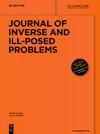通过积分观测确定随时间变化的有效离子碰撞频率
IF 0.9
4区 数学
Q2 MATHEMATICS
引用次数: 0
摘要
材料物理性质的鉴定非常重要,因为它们通常是未知的。此外,直接进行实验测量可能成本高昂且不准确。在这种情况下,一个廉价而有效的替代方法是用数学方法来提出一个逆问题,但这个问题很难解决,一般来说,可以用数值方法来解决。本文研究了如何通过额外的积分观测重构卡恩-希利亚德型四阶方程中的低阶未知时变系数,该方程适用于描述托卡马克中碰撞困离子模式的非线性饱和。利用罗特方法确定了该逆问题解的局部存在性和唯一性。此外,还推导出了未知系数对测量数据的连续依赖性。接下来,应用 Tikhonov 正则化方法从噪声测量中恢复未知系数。通过研究辅助线性四阶逆源问题,得出最小化的稳定性估计值。因此,可以验证变异源条件。然后在这种源条件下得到收敛速率。本文章由计算机程序翻译,如有差异,请以英文原文为准。
Determination of the time-dependent effective ion collision frequency from an integral observation
Identification of physical properties of materials is very important because they are in general unknown. Furthermore, their direct experimental measurement could be costly and inaccurate. In such a situation, a cheap and efficient alternative is to mathematically formulate an inverse, but difficult, problem that can be solved, in general, numerically; the challenge being that the problem is, in general, nonlinear and ill-posed. In this paper, the reconstruction of a lower-order unknown time-dependent coefficient in a Cahn–Hilliard-type fourth-order equation from an additional integral observation, which has application to characterizing the nonlinear saturation of the collisional trapped-ion mode in a tokamak, is investigated. The local existence and uniqueness of the solution to such inverse problem is established by utilizing the Rothe method. Moreover, the continuous dependence of the unknown coefficient upon the measured data is derived. Next, the Tikhonov regularization method is applied to recover the unknown coefficient from noisy measurements. The stability estimate of the minimizer is derived by investigating an auxiliary linear fourth-order inverse source problem. Henceforth, the variational source condition can be verified. Then the convergence rate is obtained under such source condition.
求助全文
通过发布文献求助,成功后即可免费获取论文全文。
去求助
来源期刊

Journal of Inverse and Ill-Posed Problems
MATHEMATICS, APPLIED-MATHEMATICS
CiteScore
2.60
自引率
9.10%
发文量
48
审稿时长
>12 weeks
期刊介绍:
This journal aims to present original articles on the theory, numerics and applications of inverse and ill-posed problems. These inverse and ill-posed problems arise in mathematical physics and mathematical analysis, geophysics, acoustics, electrodynamics, tomography, medicine, ecology, financial mathematics etc. Articles on the construction and justification of new numerical algorithms of inverse problem solutions are also published.
Issues of the Journal of Inverse and Ill-Posed Problems contain high quality papers which have an innovative approach and topical interest.
The following topics are covered:
Inverse problems
existence and uniqueness theorems
stability estimates
optimization and identification problems
numerical methods
Ill-posed problems
regularization theory
operator equations
integral geometry
Applications
inverse problems in geophysics, electrodynamics and acoustics
inverse problems in ecology
inverse and ill-posed problems in medicine
mathematical problems of tomography
 求助内容:
求助内容: 应助结果提醒方式:
应助结果提醒方式:


